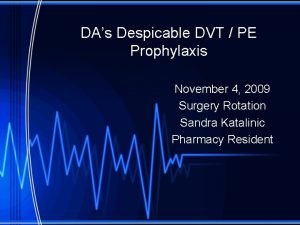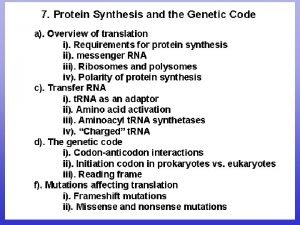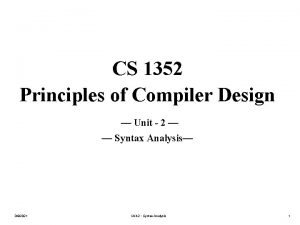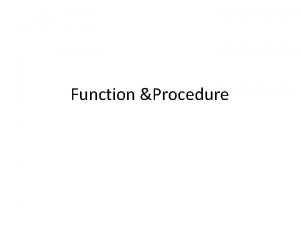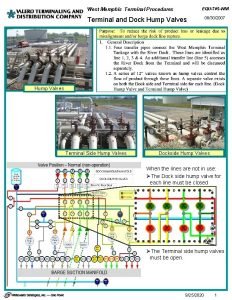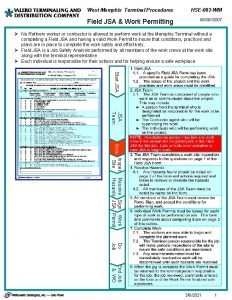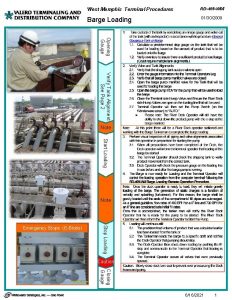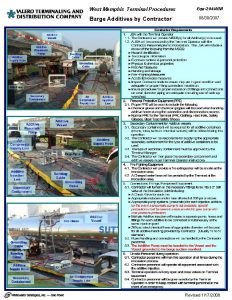West Memphis Terminal Procedures 0707200 7 VISUAL APPEARANCE





- Slides: 5

West Memphis Terminal Procedures 07/07/200 7 VISUAL APPEARANCE TEST – “WHITE BUCKET” Date Time Initials 1. Note: . Use care and vigilance when performing the Visual Appearance test. Slight traces of water, solids or unusual color may indicate the presence of product mixes or other contaminants that could cause aviation fuel to be off specification and unacceptable for aircraft use. 2. Examine and wipe clean, if necessary, the glass jar or “White Bucket” to make sure that it is clean and dry. 3. Be sure the sampling valve or truck manifold is free of loose solid contaminants. If necessary, clean the sampling tap exit of loose rust, dust or foreign matter with a cloth. 4. For storage tanks, be sure to displace the fuel volume in the piping between the sample tap and the storage tank sampling connection. Also, for tank water drains, displace the water draw-off line volume between the sample tap and the tank water drain sump. 5. Take a fuel sample into a 1 -quart clear, clean, dry, glass jar OR into a clean, bonded, minimum 2 -gallon “White Bucket”. Draw sample for field test under operating pressure, if possible, directly into the test container. 6. Fill the glass jar about 75 to 85 % full OR the “White Bucket” to an approximate depth of 6 to 8 inches from each sample source, e. g. , truck compartment or filter or tank sample tap or water sump drain. 7. Immediately on drawing sample place the sample into a welllighted area. Allow the sample to stand for one minute or more, if necessary, to remove air bubbles; and then visually check the sample for an acceptable “Clear & Bright” appearance. 8. Note: View the sample under normal daylight conditions or under “daylight” balanced lighting. Lighting shall be adequate at night for safe operation and visual truck inspection prior to loading and visual inspection of loaded product samples for “Clear & Bright”. White incandescent lighting is required since yellow sodium lighting or blue florescent lighting (or other colored lighting) can distort the visual color of the aviation fuel. 9. The terms “Clear & Bright” have no relation to the fuel’s natural color. “Clear” means the absence of sediment or emulsion such as rust or concentrated surfactant. “Bright” refers to the fluorescent appearance of fuel that does not have a cloud or haze such as that caused by fine water droplets. “Clear & Bright” when applied to an aviation fuel sample means that the fuel is free of visible solids, contamination and water (including any water resting on the bottom or sides of the sample container), and possesses an inherent brilliance and sparkle in the presence of light. Although traditionally called “Clear & Bright”, these characteristics are sometimes described as “Clean & Dry”. 10. An aviation fuel sample can appear hazy or cloudy because of the presence of water or dirt. Of these two, water is more often the cause of the haze. Gross contamination by very fine particles of dirt capable of causing a haze is not often encountered. 11. Clear glass jar sample containers shall be held up to the light source and view the fuel through the walls of the container, visually examine for haze, or lack of clarity, particulates and unusual color. Alternatively, the “White Bucket” sample shall be inspected through the full depth of product for clarity and color, and the bottom of the bucket shall be inspected for the presence of solids or water droplets. 12. Carefully swirl the container to create a vortex to concentrate any solids and/or water. This action will help in the visual check for water and dirt. Any free water and/or dirt will collect and concentrate under the vortex at the bottom and center of the container. Free water may also appear as a separate layer on the bottom. 13. Inspect the bottom surface for evidence of solids. Also, inspect the fuel for haze, water droplets and other unusual appearance, such as black/brown slime or scum. 14. Haze can also be detected by dropping a shiny coin into the white bucket. If the coin characteristics can easily be distinguished, the fuel is considered neither hazy nor cloudy. 15. Inspect the aviation fuel for color. Jet fuel is normally “water white” or “straw colored”. Unusual color in aviation fuel may 1 or result from crude oil characteristics or 6/9/2021 refinery processing

West Memphis Terminal Procedures Table 1 - Particulate or Solid Contaminant Acceptable Rating 07/07/200 7 Unacceptable Ratings “Clear” (or Clean) Slight Particulates No particles, silt, sediment, flakes, dye, rust or solids Slight to several fine to small size particles Particulate Matter Many small particles floating or settled on the bottom of container Dirty Discoloration or many particles dispersed in fuel or settled on the bottom of container 6/9/2021 2

West Memphis Terminal Procedures 07/07/200 7 Table 2 - Moisture or Water Contaminant Acceptable Ratings Unacceptable Ratings “Bright” (or Dry) Hazy Brightness is a quality independent of the color of the sample and refers to the lack of suspended or visible free water in the sample. Bright fuel tends to sparkle. Air bubbles may cause hazy appearance during the first minute immediately after the sample is drawn, but haze clears from the bottom up. A condition resulting from fine droplets of moisture dispersed throughout the sample producing a dull hazy appearance. This may be temporary due to sample cooling. Cloudy The result of extremely fine droplets of water dispersed throughout the sample giving it a milky appearance. Wet Any form of free water in the form of droplets or bulk water layer on the bottom of the bucket or clinging to the sides. 6/9/2021 3

West Memphis Terminal Procedures 07/07/200 7 Table 3 – Other Contaminants Description of Sample Appearance Possible Causes Slime on the bottom of the container or at the fuel/water interface, appearing as a dark brown/black layer; or scum or lacy material floating in the fuel or at interface with water Surfactant (Surface Active) Contamination Appearance of microbial contamination depends upon the presence of bacteria, fungus or yeast or other microorganism. Biological activity is generally observed on the fuel/water interface with a layer of scum, slime or lacy material floating in the fuel phase. The presence of anaerobic bacteria often causes a pungent odor, similar to rotten eggs. Microbiological Activity Unusual appearance, color and/or odor Fuel dyes can cause red, green, blue or any color combination in aviation fuel Other Product Cross. Contamination Dye Contamination Darkened, discolored, and possibly more viscous fuel with abnormal odor Fuel Aging Caution: Unusual odor should be apparent without placing sample close to nose. Do not inhale fumes. 6/9/2021 4

West Memphis Terminal Procedures 07/07/200 7 6/9/2021 5

